Cepallet® series
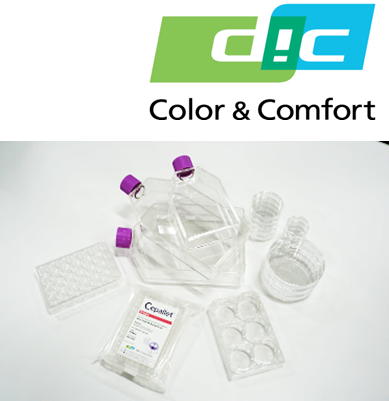
Cepallet® is temperature-reacting cultureware whose surface is hydrophobic and adhesive property to cell during cell culturing, while it changes to hydrophilic and un-adhesive property at the lower temperature. Cultured cells can be harvested simply by adding a cold medium with Cepallet®. The damage to cells is suppressed due to not using enzyme or scraper.
Features
- Simple steps
・ Only exchange to cold medium
・ No operations such as rinse in PBS or enzyme treatments
・ Suitable for automated cell culture system/li> - No damage and High recovery rate
・ No enzyme and scraping process
・ No damage to antigens on the surface of the cell
・ Suppress cell re-adhesion
Usage
The usage of Cepallet® in culturing and collecting
Cell Culture
- Your cells can be seeded in the same way as usual.
- The media is recommended that it is previously warmed at 37 ℃.
- When the temperature of the medium decreases, the cells will be easy to exfoliate. Therefore, long-term microscopic observation should not be recommended.
- Coating of extracellular matrices are possibly effective for cells which do not adhere well.
(Due to the property of the product, we recommend a longer incubation period than the usual coating. And, coating of matrices may not go well at low temperatures.)
Cell Harvesting
- Surface of Cepallet® becomes hydrophilic below 32 ℃ and cells are difficult to adhere on the substrate.
- After cell culture, the Cepallet® is removed from the incubator.
- Remove the medium using an aspirator.
- Add 4℃ cooled medium to the Cepallet® and let it stand for 5 minutes at room temperature. (It will return to room temperature in about 1 minute.)
- If you are concerned about the addition of the medium at 4 ℃, you can use the medium at 20 ℃ and leave it at room temperature for about 30 minutes.
- Pipetting of medium can be good for the detachment of cells in case cells can not be collected completely.
However, there are sometimes low collecting rate depends on a kind of cells or culture conditions.
Precautions for Use
This product is for laboratory and research use only. Not intended for diagnostic, therapeutic or human.
Storage Method
Store at room temperature and away from sunlight.
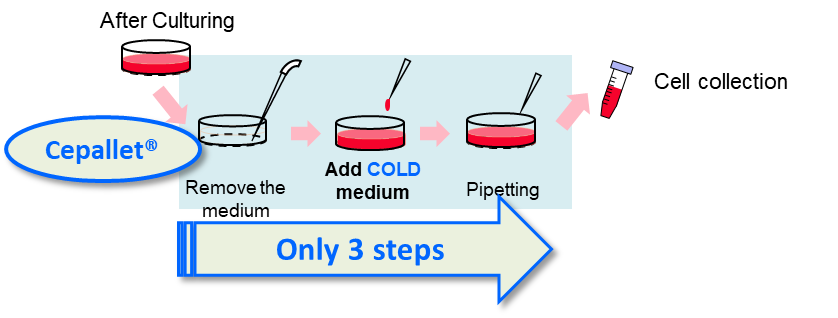

Example of use
Detachment of Mesenchymal stem cells
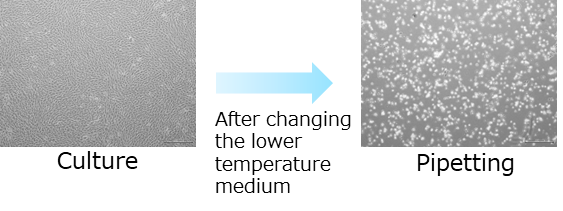
-
Cell culture condition
- Bone-marrow derived Mesenchymal stem cells 3 days
- Culture medium: Mesenchymal Stem
- Cell Growth Medium (Promocell)
Passage of rat adrenal pheochromocytoma (PC12) cells induced by nerve growth factor (NGF)
| Cells cultured on Cepallet® Cultureware. Then harvested by thermal treatment, and re-seeded on the TC-treated Cultureware. | Cells cultured on TC-treated Cultureware. Then harvested by enzymatically, and re-seeded on the TC-treated culture Cultureware. |
Cell culture condition
|
 |
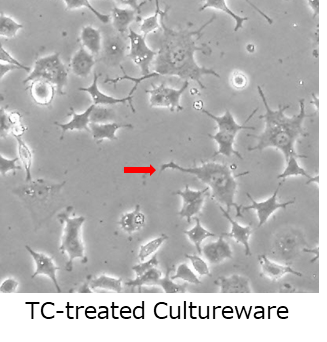 |
[Advantage] Observed neurite extension
Detachment of Macrophages (THP-1 cells PMA stimulated)
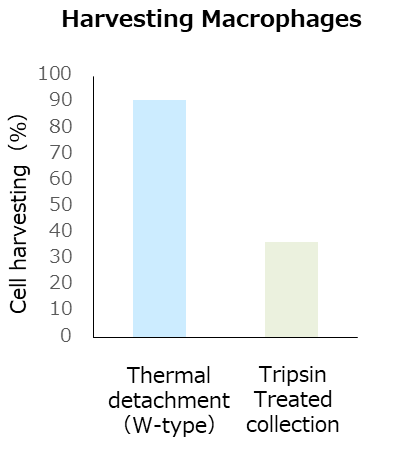

Cell culture condition
- Culture medium: RPMI-1640
- 10% FBS, Gentamicin
- Treated with PMA (50ng/mL) for 2 days
[Advantage] Applicable to activated Macrophages
Applications
| ・iPS cell-derived differentiated cells | ・Neurons | ・Mesenchymal cells | ・Macrophages |
| ・Fibroblasts | ・Primary cells | ・Cell lines | etc… |
Product List
- Open All
- Close All
W-type Dishes (Wide use)












S-type Dishes (for Stem cells)












W-type Plates (Wide use)












S-type Plates (for Stem cells)












Flasks (Wide use)












For research use or further manufacturing use only. Not for use in diagnostic procedures.
Product content may differ from the actual image due to minor specification changes etc.
If the revision of product standards and packaging standards has been made, there is a case where the actual product specifications and images are different.



